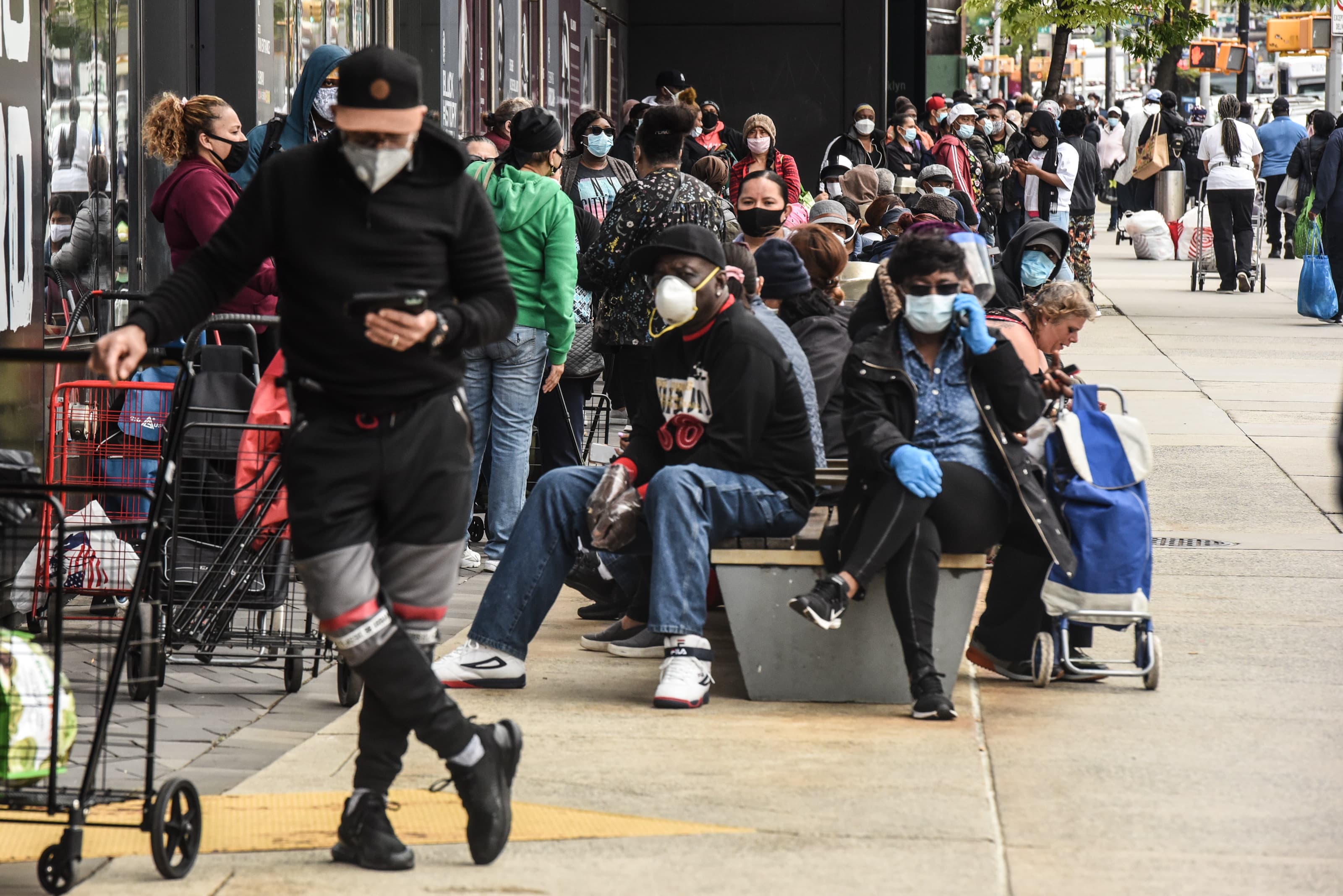People wait on a long line to receive a food bank donation at the Barclays Center on May 15, 2020 in the Brooklyn borough in New York City. The event was organized by Food Bank for New York City and included dairy and meat items.
Stephanie Keith | Getty Images
Consumers went shopping in June, spending at pre-Covid levels, but the spreading virus and still staggering number of people filing for unemployment benefits suggests the recovery may take longer than initially expected.
Economists say the risk of a further downturn makes the economy even more dependent on the next round of fiscal stimulus, expected to be considered by Congress when it returns from recess next week.
Retail sales for June jumped 7.5%, and May’s increase was revised up to 18.2%. June sales totaled $524.3 billion and were about 1.1% above the level of last June. But the government also reported Thursday that another 1.3 million people filed for first time unemployment benefits in the week ending July 11, and another 17.3 million continue to collect state benefits, down just 422,000 from the previous week.
“While we see a V now perfectly drawn in retail sales, what we are concerned about is the temporary firing and rehiring is masking an underlying traditional recessionary dynamic that has been put into motion in March and April,” said Luke Tilley, chief economist at Wilmington Trust.
Economists say the retail sales data has a slightly positive implication for second quarter gross domestic product, expected to be down more than 30%. However, July sales could turn negative with the shutdown in activity in hot spot states, and a new wave among consumers and businesses as the virus continues to spread.
“If you look at the unemployment claims, the unadjusted numbers are staggering for California, Georgia, Nevada, Florida, Arizona – all the hot spots,” said Diane Swonk, chief economist at Grant Thornton. “The June 11 week change in Florida was 62,467 unadjusted. That’s huge. It was another 22,941 of an already high claims level in California.”
The claims data for the week of July 11 represents the 17th week in a row with claims of more than 1 million.
“Our view is you have two things going on. One of them is the resurgence of he virus in different places which is going to affect GDP,” said Tilley. “You also have in the background, a traditional recessionary dynamic where people are losing their jobs and companies are cutting back on cap ex and your’e going to have those ripple effects.”
Tilley expects the economy to contract by 30% in the second quarter, and should bounce back by 20% in the third quarter, but growth will level off after that, and he expects a 6% decline in GDP for the year.
Economists in CNBC/Moody’s Analytics Rapid Update survey, as of midday Thursday, expect a median decline of 32.5% in the second quarter GDP. They also forecast a median 23.5% gain in the third quarter, and for the fourth quarter, the economists are forecasting a gain of 7%.
Tilley said the stimulus has boosted retail sales, including the direct payment that amounted to $1,200 for individuals. Congress is expected to debate whether to provide another direct payment and whether to extend or cut a weekly federal payment of $600 to individuals collecting benefits, The extended benefits are set to stop at the end of the month, unless Congress acts.
Congress has also provided Pandemic Unemployment Assistance payments to millions of gig workers and self employed individuals, who don’t qualify for state benefits and don’t show up in continuing claims data.
“You’ve got 32 million people collecting unemployment in one form or other. 32 million people are getting an extra boost of $2,400 a month. That is $80 billion a month and that is 15% of retail sales,” Tilley said. He said without that funding, which strategist expect to be cut in the next round, consumers are expected to be more reluctant to spend.
Consumers are also saving at a very high rate, but spending in the June data showed pent up demand in some sectors as stores reopened.
Clothing and accessories sales jumped 105%; sales at electronics and appliances stores rose nearly 35%, furniture sales were up more than 32%, while sporting goods sales jumped 26.5% as states reopened their economies in June.
“This is completely understandable given the pandemic,” said Tilley, noting the strength in spending could be driven by consumers who received direct checks from the government. Furniture and electronics could be used for home offices, and consumers may be spending on equipment from sporting goods stores in place of going to gyms.
“We’re worried we’re seeing an ephemeral boost from the government stimulus,” he said. Tilley said the economic recovery is caught in a race between the development of a vaccine that could allow a real reopening, and the traditional recessionary forces.
Economists say that makes government stimulus an important bridge. The projections for the size of the next package range from about $1 trillion to $2 trillion. Congress has already approved packages worth about $2.4 trillion, but this next one, which would have to resolve the unemployment spending issue as well as state aid, comes at a time of higher political tensions and with the added edge of the election just months away.
Swonk said activity has noticeably weakened since early June, and the next round of stimulus will be critical.
“Retail sales was definitely helped by the stimulus. Some of it is waning. We saw a lot of people use their stimulus checks to buy used cars and they bought food. But it’s going away, and the clock is ticking,” she said. “It’s ticking with a time bomb and we know how many of these states are getting hit again. Retail sales are just part of the picture. A lot of the activity we saw in the last two months could be very fleeting.”
